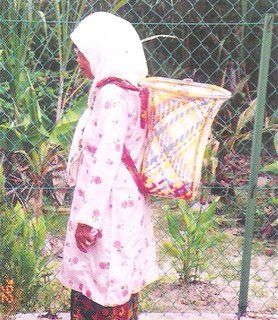The Brunei Haversack
 Sometimes we take things for granted. Take 'takiding' which is the basket that were used to carry things in Brunei Darussalam. It is not used very much or at all nowadays but everyone knows what it looks like and what it is. It was previously used mostly in farms when farm produce or fruits are picked, they are kept in the 'takiding' carried all the time at the farmer's back.
Sometimes we take things for granted. Take 'takiding' which is the basket that were used to carry things in Brunei Darussalam. It is not used very much or at all nowadays but everyone knows what it looks like and what it is. It was previously used mostly in farms when farm produce or fruits are picked, they are kept in the 'takiding' carried all the time at the farmer's back.We all know that it is made out of bamboo but not much more beyond that. According to one article I read in the Berita Muzium, one villager in 1996 described that the art of weaving bamboo into baskets was a Kedayan speciality and for the Kedayans in the Brunei/Muara District, it originated from two villages - Sengkurong and Tanjung Nangka as they formed the majority of the villagers. According to the Kulapis Village Head, another village, Mulaut was also another village where the art of weaving took place and the 'technology' was later transferred to the Kulapis villagers.
There were also other baskets weaved in other districts and there are difference between the sizes, the physical appearance as well as the names of some of the parts of the takiding. The physical parts of the takiding include the 'pusat','bisul', 'bingkai atas', 'bingkai badan', 'sirat', 'junjung', 'gariwat' and 'tali takiding'. The size of the takiding are generally sized to carry about 2 gantangs (roughly about 9 liters) of padi (uncooked rice).
To make the 'takiding', there are several materials require which include buluh (bamboo) which can be buluh tebal, buluh arnab, buluh tamiang and buluh liat. Buluh liat is also known as 'meikong buaya' literally crocodile's tail. I am not sure why. Other materials include bamban which is the bark or skin of a type of wood, rotan (mature bamboo), salingkawang (type of root - used as the rope to bind the takiding), timbaran (another skin/bark used as the harnass) and water (used to soften the other materials).
The design on the takiding is known as 'kelarai' and the kelarai have many names depending on the design. Some designs are called 'saluk kali', 'sinangkait sepanggal', 'sinangkait bulat', 'biji pelajau', 'buah bunut', 'bulan', 'mata punai', 'sayap kulimbambang' , 'tangkai gayung', 'buah bangkal', 'bisik damit', 'bisik besar', 'guramai lilipan', 'pucuk siar', 'ungsut' and 'adiemu',
The whole article in the Berita Muzium actually described the whole art of the weaving - made up of about 10 separate steps. I won't go into detail but I will make the whole article available on pdf and will post it up on main library at www.bruneiresources.com.


Comments